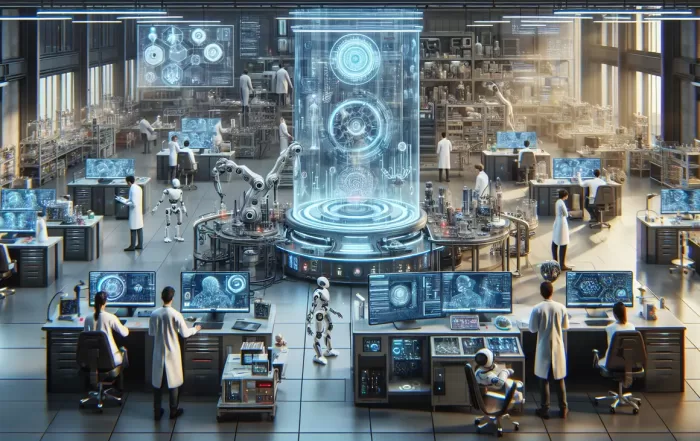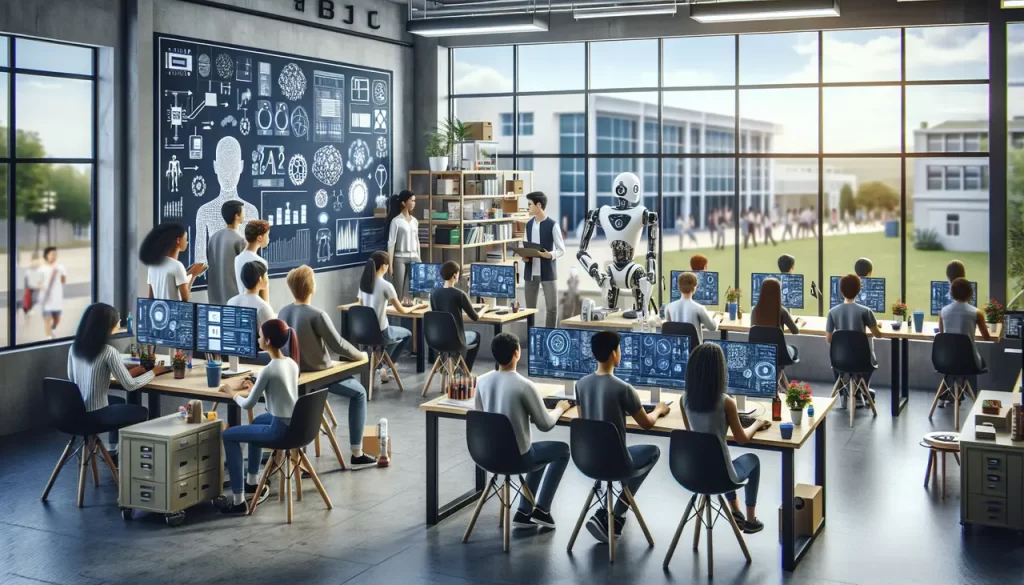GESS Dubai 2025 | 11-13 November | Booth No. D10
- 00Days
- 00Hrs
- 00Mins
- 00Secs

In recent years, the integration of artificial intelligence into educational environments has transformed how we approach STEM education. By incorporating AI lab setups, educators can offer students a more hands-on and immersive learning experience. This blog explores how these setups enhance educational outcomes in science, technology, engineering, and mathematics.

AI has emerged as a pivotal component in modern education, enabling personalized learning and data-driven instruction. It is reshaping traditional teaching methodologies and providing new avenues for student engagement. AI technologies enable educators to customize the learning experience, tailoring it to the needs of individual students based on varied parameters like learning pace, interests, and performance history. For instance, AI algorithms can assess a student’s strengths and weaknesses, suggesting targeted resources to bolster comprehension in challenging areas. This level of personalization can transform the learning environment, making education more interactive and responsive.
Furthermore, AI-driven analytics tools present teachers with significant insights into classroom dynamics and students’ academic progress. These insights can inform pedagogical strategies, helping educators identify where students may require additional support and adjust their teaching approaches accordingly. The AIOT and STEM concepts further illustrate the impact of integrating AI in education by demonstrating the synergy of AI with the Internet of Things. Such integration facilitates not just streamlined data gathering but also the automation of routine tasks, allowing educators to focus more on personalized instruction and building relationships with students.
An artificial intelligence lab typically includes advanced software, hardware, and cloud resources that enable students to explore AI concepts. Key components can include AI programming tools, machine learning platforms, and robotics kits. These components create a robust framework where students can practice programming AI models, run simulations, and observe results in real-time. The integration of platforms like Python and TensorFlow allows for experimentation with machine learning algorithms and data sets, fostering a deeper understanding of AI processes.
Beyond software, AI labs will often incorporate cutting-edge equipment such as AI-powered robots and IoT devices, offering practical insights into automation and smart technologies. The Robot Lab AI Lab offers an example of such a comprehensive, turnkey learning environment, designed to optimize students’ exposure to the multifaceted world of AI. Providing an active, hands-on learning space, AI labs serve as essential incubators for budding innovators, offering environments where theoretical knowledge can be applied in solving real-world problems.
Additionally, AI labs frequently utilize cloud-based resources to enhance computing capabilities, making it possible to analyze vast datasets efficiently. Cloud servers enable students to access their projects and collaborate with peers, regardless of their physical location. This connectivity reinforces global collaboration within educational realms and opens doors to international perspectives. Incorporating advanced AI stations and cloud systems lays the groundwork for an integrative learning model that prepares students for the digital age.
AI labs facilitate interactive learning by allowing students to actively participate in experiments and projects. This engagement is crucial in helping students understand complex STEM concepts and develop problem-solving skills. By simulating real-world scenarios through interactive platforms, AI labs transform passive learners into active problem-solvers. Students are encouraged to delve deeper into subjects by experimenting with AI models, observing outcomes, and iteratively improving their approaches.
Interactive learning environments, like those enhanced by AI, empower students to take charge of their education. For example, using AI-powered virtual labs and simulations, students can visualize abstract concepts and participate in hands-on activities that reinforce theoretical learning. Such environments not only foster deeper understanding but also stimulate enthusiasm and curiosity among students, encouraging them to explore new ideas and applications of STEM principles. Research has shown that involved students often exhibit higher retention rates and superior understanding, attributing to improved academic outcomes. AI-driven tools support this interactive pedagogy by offering personalized, responsive feedback, promoting a more engaging, adaptive learning cycle.
Moreover, AI technology in educational setups allows educators to create immersive experiences that extend beyond traditional boundaries. Techniques like virtual reality (VR) and augmented reality (AR), powered by AI, offer experiential learning opportunities that captivate the imagination and enhance cognitive learning. These technologies allow for re-creations of historical events and complex experiments, which can be otherwise inaccessible in conventional settings. Thus, utilizing AI in interactive learning settings not only makes education more engaging and effective but also turns classrooms into arenas of creativity and innovation.
AI labs provide students with opportunities to work on real-world applications, bridging the gap between theoretical knowledge and practical skills. This preparation is essential as industries increasingly rely on AI technologies. By enabling access to real-world scenarios, such as designing AI-driven solutions for everyday problems, students gain critical skills that are transferable to professional environments. Hands-on projects, like robotics automation or data-driven decision models, are key in equipping students with competencies that are highly valued across sectors.
Furthermore, AI labs embody the cutting edge of technology, reflecting the broader trends shaping industry evolution. Students in AI labs are exposed to the latest AI tools and practices, allowing them to stay abreast of innovations and prepare for future job roles that may not yet exist. Programs such as modern AI lab setups not only cultivate technical proficiencies but also enhance soft skills like critical thinking and adaptability. These competencies are crucial in preparing students to meet the demands of fast-paced, technologically driven work environments.
While AI labs offer numerous benefits, educators must consider challenges such as cost, accessibility, and the need for teacher training. Successfully addressing these factors is key to maximizing the impact of AI in education. The cost of setting up an AI lab can be substantial given the need for sophisticated equipment, software licenses, and technical maintenance. Schools must consider budgeting and sourcing strategies wisely to sustainably implement these setups.
Accessibility is also a significant consideration. Ensuring that all students have equal access to these advanced learning tools is necessary to promote inclusivity in STEM education. Leveraging online platforms and providing flexible learning resources can help bridge any gaps that arise from geographic or socio-economic disparities. Additionally, teacher training is crucial; educators must be well-versed in AI technologies to effectively integrate them into the curriculum. Professional development programs focused on AI and related technologies can empower teachers to harness AI labs’ full potential, enriching the learning experience.
Artificial intelligence lab setups are at the forefront of transforming STEM education. By providing dynamic, interactive experiences, these labs prepare students for future technological advancements and foster critical STEM skills. As education evolves, incorporating AI within the classroom will be vital in cultivating the innovators and problem-solvers of tomorrow.
No comment